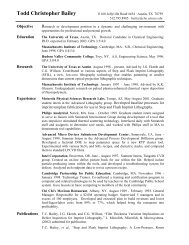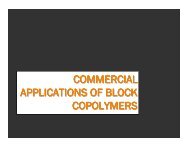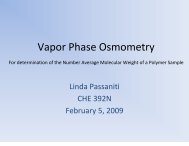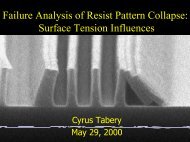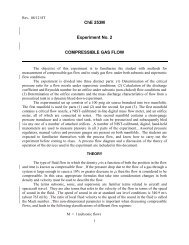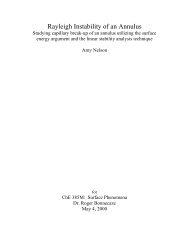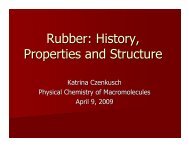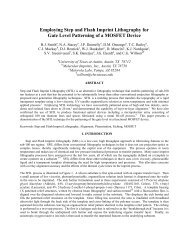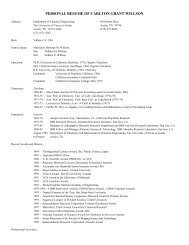Lecture 12
Lecture 12
Lecture 12
You also want an ePaper? Increase the reach of your titles
YUMPU automatically turns print PDFs into web optimized ePapers that Google loves.
Macromolecular Chemistry<br />
10<br />
5<br />
0.5<br />
0.1<br />
<strong>Lecture</strong> <strong>12</strong><br />
Chemistry 367L/392N
Chain Transfer in Free Radical<br />
Polymerization<br />
A termination and re-initiation reaction<br />
For Chain Transfer Y• must be able to re-initiate reaction<br />
Chemistry 367L/392N
Chain Transfer Agents (CTAs(<br />
CTAs)<br />
Thiols are efficient examples<br />
Chemistry 367L/392N
Measurement of Chain Transfer Constants<br />
The Mayo Equation:<br />
1 1<br />
=<br />
DP n DP 0<br />
⎡Transfer agent<br />
+ Cs⎢<br />
⎣ monomer<br />
⎤<br />
⎥<br />
⎦<br />
DP n<br />
DP o<br />
C S<br />
= degree of polymerisation WITH transfer agent<br />
= degree of polymerisation WITHOUT transfer agent<br />
= Chain Transfer “constant” or “coefficient”<br />
Chemistry 367L/392N
Generic Mayo plot<br />
1/DP<br />
Cs<br />
1/DP 0<br />
[S]/[M]<br />
Chemistry 367L/392N
Butylated<br />
HydroxyTolueneoluene<br />
<br />
<br />
BHT radical will not initiate new chains<br />
So…BHT is an inhibitor, not a CTA<br />
Chemistry 367L/392N
Interesting “Inhibitors”….<br />
N<br />
O<br />
Phenyl-a-t-butylnitrone<br />
PBN<br />
N<br />
O<br />
TEMPO<br />
Chemistry 367L/392N
Chemistry 367L/392N
Chemistry 367L/392N
Free Radical Copolymerization<br />
What happens when we initiate a<br />
polymerization in a mixture of monmers<br />
M 1 +M 2 → -[(M 1 ) x -(M<br />
2 ) y ] n -<br />
AIBN<br />
Random Copolymers M 1 M 2 M 1 M 1 M 2 M 2 M 2 M 1 M 1 M 2<br />
Block Copolymers M 1 M 1 M 1 M 1 M 2 M 2 M 2 M 2 M 2 M 2<br />
Alternating Copolymers M 1 M 2 M 1 M 2 M 1 M 2 M 1 M 2 M 1 M 2<br />
Chemistry 367L/392N
Free Radical Co-polymerization<br />
Free Radical Copolymerization<br />
~<br />
~<br />
~<br />
~<br />
~<br />
~<br />
~<br />
~<br />
Assume chain end concentrations are constant at “steady state”<br />
Chemistry 367L/392N
a<br />
b<br />
is a/b<br />
Do the algebra -see<br />
pages 467-469 !!<br />
Chemistry 367L/392N
If r<br />
If r1 > 1 >1 this means that ~M<br />
1<br />
1 • adds M 1 more readily<br />
than M<br />
means 2 . If r 1 is zero then M 1 does not undergo<br />
homopolymerization!!<br />
This important relationship can be expressed in<br />
terms of mole fractions rather than concentrations<br />
Chemistry 367L/392N
Supplementary<br />
Homework!<br />
This gives the Instantaneous mole<br />
fraction of M 1 in the copolymer<br />
Chemistry 367L/392N
How does one determine the<br />
reactivity rations<br />
•Fineman Method<br />
•Kelen-Tudos Method<br />
Chemistry 367L/392N
Chemistry 367L/392N
Chemistry 367L/392N
Chemistry 367L/392N
1.0<br />
Ideal copolymer<br />
Fa (polymer composition)<br />
0.8<br />
0.6<br />
0.4<br />
0.2<br />
A = styrene<br />
B = butadiene<br />
ra = 0.75, rb = 1.3<br />
0.0<br />
0.0 0.2 0.4 0.6 0.8 1.0<br />
fa (monomer composition)<br />
Chemistry 367L/392N
Fa (polymer composition)<br />
1.0<br />
0.9<br />
0.8<br />
0.7<br />
0.6<br />
0.5<br />
0.4<br />
0.3<br />
0.2<br />
0.1<br />
Alternating Copolymer<br />
A = styrene<br />
B = maleic anhydride<br />
ra = 0.05, rb = 0.0<br />
0.0<br />
0.0 0.2 0.4 0.6 0.8 1.0<br />
fa (monomer composition)<br />
Chemistry 367L/392N
1.0<br />
Rich in one monomer<br />
Fa (composition of polymer)<br />
0.8<br />
0.6<br />
0.4<br />
0.2<br />
A = vinyl acetate<br />
B = styrene<br />
ra = 0.01, rb = 50<br />
0.0<br />
0.0 0.2 0.4 0.6 0.8 1.0<br />
fa (Composition of monomer)<br />
Chemistry 367L/392N
1.0<br />
Quite typical copolymerisation<br />
Fa (polymer composition)<br />
0.8<br />
0.6<br />
0.4<br />
0.2<br />
A = Acrylonitrile<br />
B = Butadiene<br />
ra = 0.046, rb = 0.36<br />
0.0<br />
0.0 0.2 0.4 0.6 0.8 1.0<br />
fa (monomer composition)<br />
Chemistry 367L/392N



